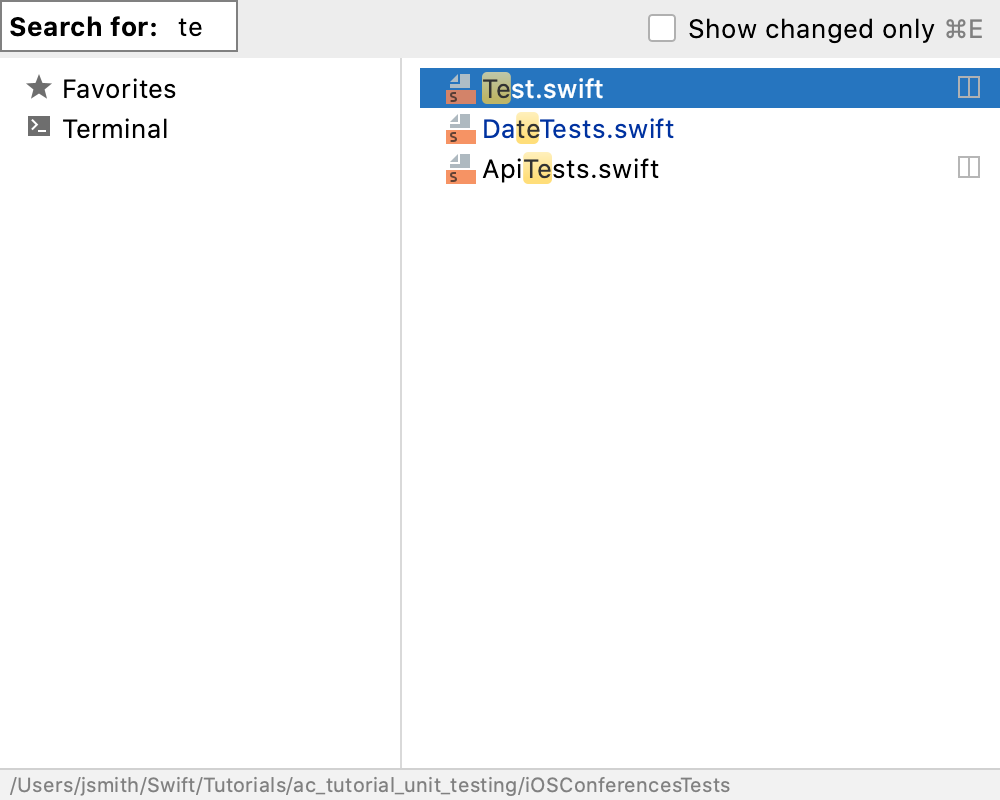Code navigation
You can quickly navigate through code in the editor using different actions and popups. For the detailed information on navigating between the editor and tool windows, check the editor basics.
Navigate with the caret
To navigate backwards, press ⌃⌥←. To navigate forward, press ⌃⌥→.
To navigate to the last edited location, press ⌃⇧⌫.
To find the current caret location in the editor, press ↑ and ↓ arrow keys.
To highlight a word at the caret you are trying to locate, select from the main menu.
To see on what element the caret is currently positioned, press ⌥Q.
To move caret between matching code block braces, press ⌃⇧M.
To navigate to the code block start, press ⌃[, with the caret anywhere inside the code block. If the caret is already at the opening brace, press ⌃[ to jump to the start of the higher code block.
To navigate to the code block end, press ⌃], with the caret anywhere inside the code block. If the caret is already at the closing brace, press ⌃[ to jump to the end of the higher code block.
To navigate between code blocks, press ⌃⇧[ or ⌃⇧].
Move the caret
You can use different actions to move the caret through code. You can also configure where the caret should stop when moved by words and on line breaks.
To move the caret to the next word or the previous word, press ⌃→ or ⌃←.
By default, AppCode moves the caret to the end of the current word.
When you move the caret to the previous word, the caret is placed in the beginning of the current word. You can configure the position of the caret when you use these actions.
In the Preferences dialog ⌃⌥S, go to . In the Caret Movement section, use the When moving by words and Upon line break options to configure the caret's behavior.
To move the caret forward to the next paragraph or backward to the previous one, press ⌃⇧A and search for the Move Caret Forward a Paragraph or Move Caret Backward a Paragraph action.
You can also select a text and then move the caret forward or backward to a paragraph. Press ⌃⇧A and search for the Move Caret Forward a Paragraph with Selection or Move Caret Backward a Paragraph with Selection action.
If you need, you can assign shortcuts to these actions. Refer to Configure keyboard shortcuts for details.
Find recent locations
You can also check your recently viewed or changed code using the Recent Locations popup.
To open the Recent Locations popup, press ⌃⇧E. The list starts with the latest visited location at the top and contains code snippets.
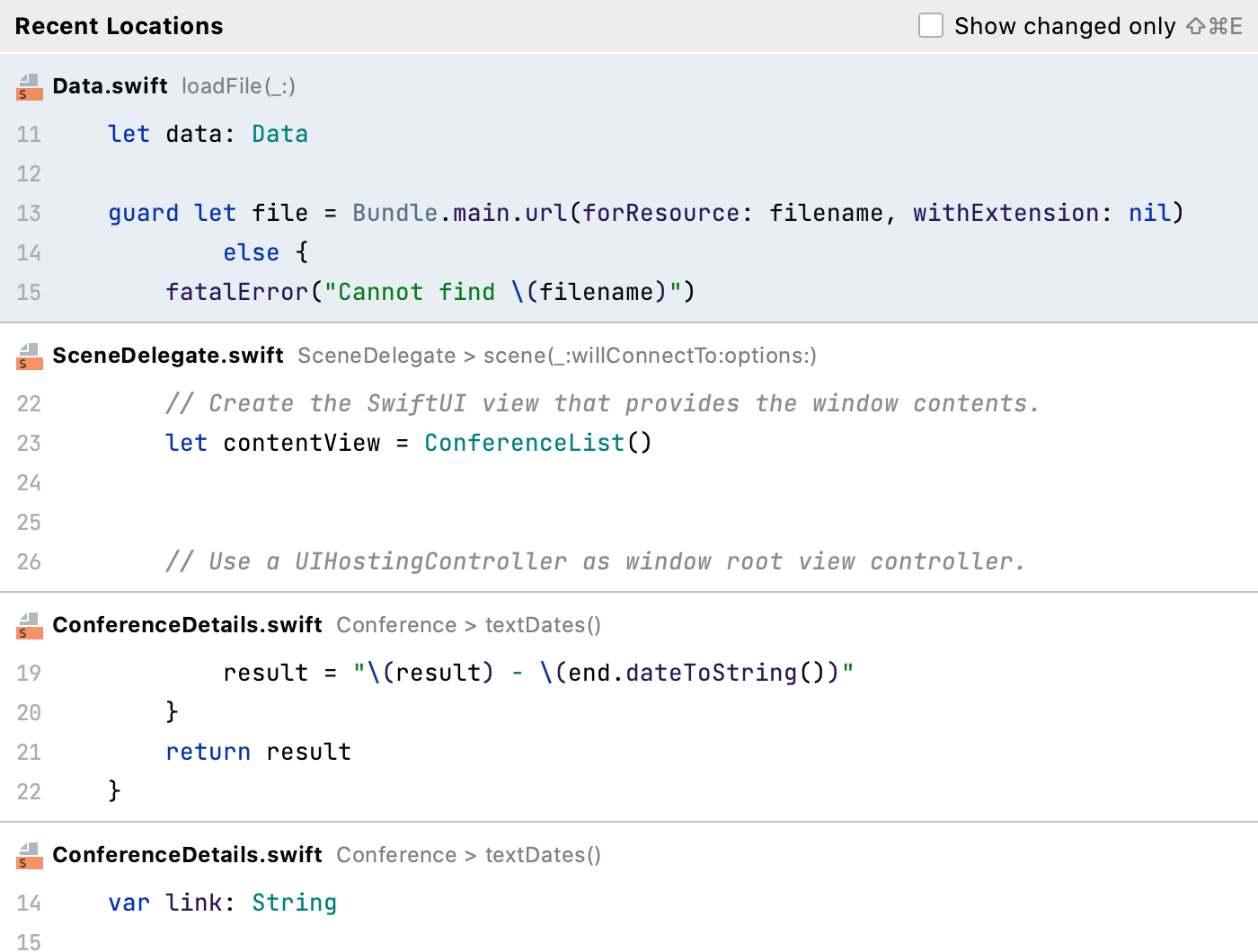
While in the popup, use the same shortcut or select the Show changed only checkbox to see only the locations with changed code.
To search for a code snippet, in the Recent Locations popup, start typing your search query. You can search by the code text, filename, or breadcrumbs.
To delete a location entry from the search results, press either Delete or ⌫.
Keep in mind that the deleted location is also removed from the list of entries that you access with the ⌃⌥← shortcut.
Use bookmarks for navigation
To create an anonymous bookmark, place the caret at the needed code line and press F11.
To create a bookmark with mnemonics, place the caret at the needed code line, press ⌃F11 and select a number or a letter for the mnemonics.
To show the next or the previous bookmark, in the main menu select or .
To open the Bookmarks dialog, press ⇧F11. You can use this dialog to manage bookmarks, for example, delete, sort bookmarks, or supply them with a brief description.
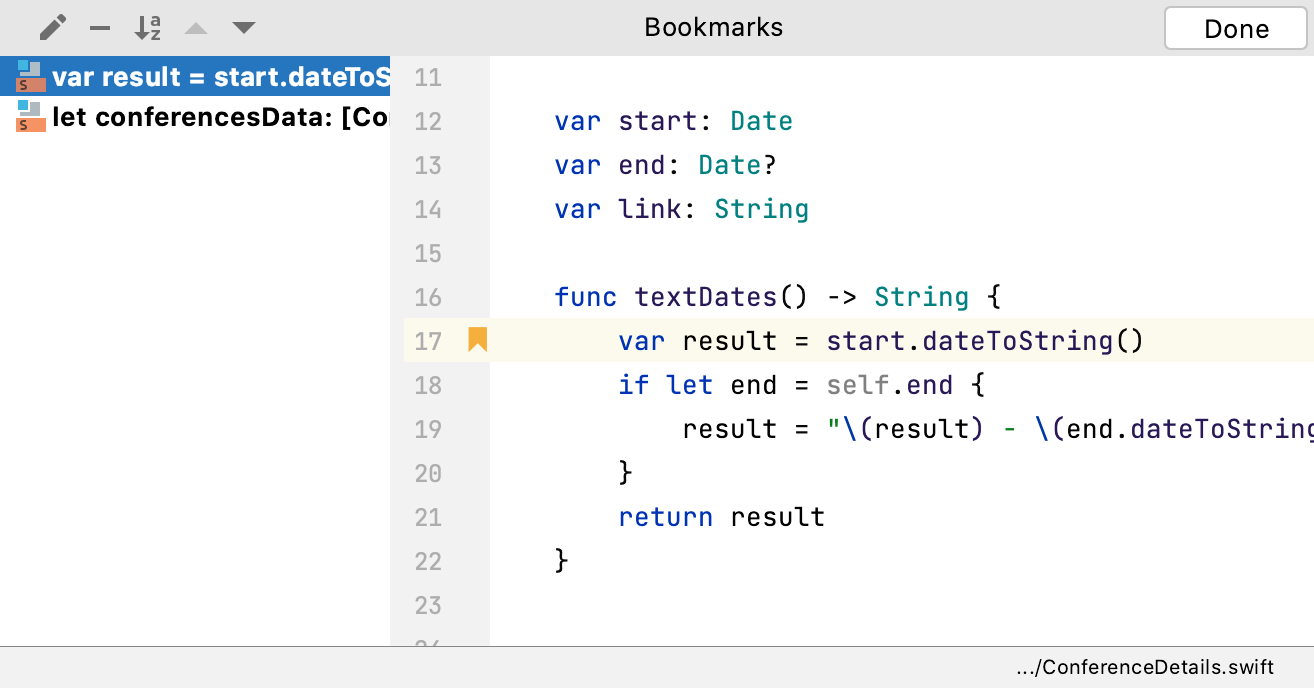
To navigate to an existing bookmark with letter mnemonics, press ⇧F11 and then press a letter you need. AppCode returns you to the editor and to the corresponding bookmark.
To navigate to an existing bookmark with number mnemonics, press Ctrl and the bookmark's number.
Every created bookmark is reflected in the Favorites ⌥2 () tool window which you can also use for navigation to your bookmarks.
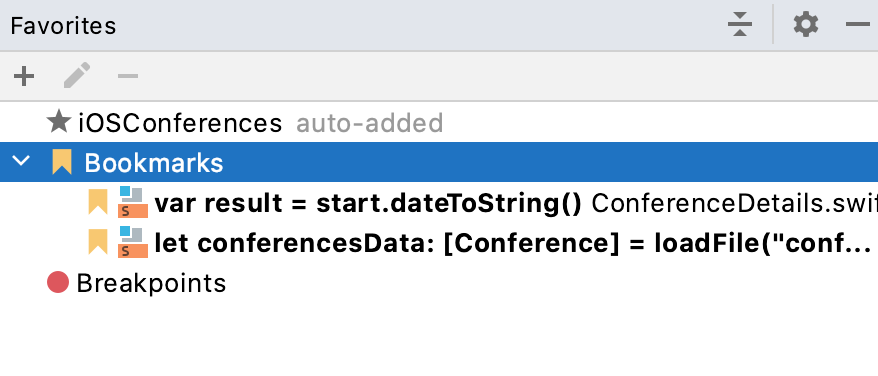
Navigate between changes
Press ⌃⌥⇧↓/ ⌃⌥⇧↑.
From the main menu, choose .
Click a change marker, and then click
or
.
You can navigate to the initial declaration of a symbol and symbol's type from its usage.
Go to declaration and its type
Place the caret at the desired symbol and press ⌃B.

Alternatively, use Ctrl+Click: keeping Ctrl pressed, hover your mouse pointer over the symbol. When the symbol turns into a hyperlink, its declaration will be displayed in the tooltip. Click the hyperlink without releasing the key to open the declaration in the editor.
For a type declaration, press ⌃⇧B.
Go to implementation
You can keep track of class implementations and overriding methods either using the gutter icons in the editor or pressing the appropriate shortcuts.
Click one of the
/
,
/
gutter icons located in the editor and select the desired ascendant or descendant class from the list.
To navigate to the super method, press ⌃U.
To navigate to the implementation, press ⌃⌥B.
Navigate with the Select In popup
You can automatically locate a class in the Project tool window.
If the class is opened in the editor, press ⌥F1 to open the Select In popup.
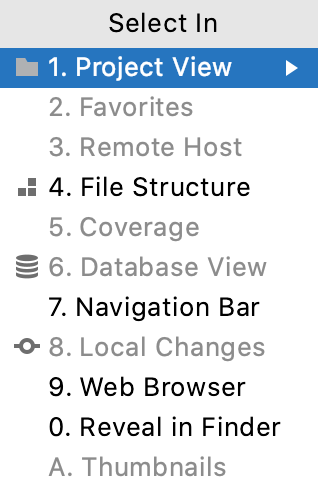
In the popup, select Project View and press ⏎. AppCode locates your target in the Project tool window.
Locate a file in the Project tool window
You can use the Open Files with Single Click (previously called Autoscroll to Source) and Always Select Opened Files (previously called Autoscroll from Source) actions to locate your file in the Project tool window.
In the Project tool window, right-click the Project toolbar and from the context menu select Always Select Opened File. After that AppCode will track the file that is currently opened in the active editor tab and locate it in the Project tool window automatically.
You can also select the Open Files with Single Click option. In this case, when you click a file in the Project view, AppCode will automatically open it in the editor.
Navigate between errors or warnings
To jump to the next or previous found issue in your code, press F2 or ⇧F2 respectively. Alternatively, from the main menu, select .
AppCode places the caret immediately before the code issue.
Configure the way AppCode navigates between code issues: it can either jump between all code issues or skip minor issues and only navigate between detected errors. Right-click the code analysis marker in the scroll bar area and choose one of the available navigation modes from the context menu:
To have AppCode skip warnings, infos, and other minor issues, choose Go to high priority problems only.
To have AppCode jump between all detected code issues, choose Go to next problem.
Locate a code element with the Structure view popup
You can use the structure view popup to locate a code element in the file you are working on.
To open the structure view popup, press ⌃F12.
In the popup, locate an item you need. You can start typing a name of the element for AppCode to narrow down the search. Press ⏎ to return to the editor and the corresponding element.
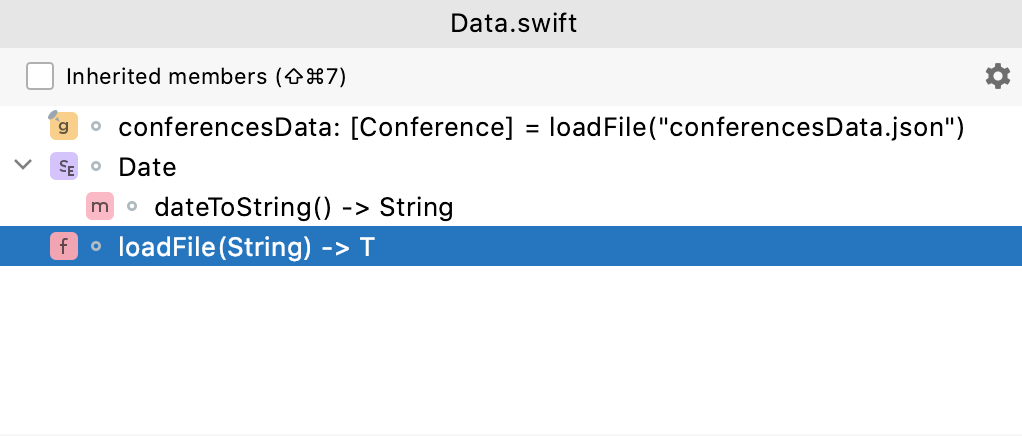
Browse through methods
To visually separate methods in code, in the Preferences dialog ⌃⌥S, go to and select the Show method separators option.
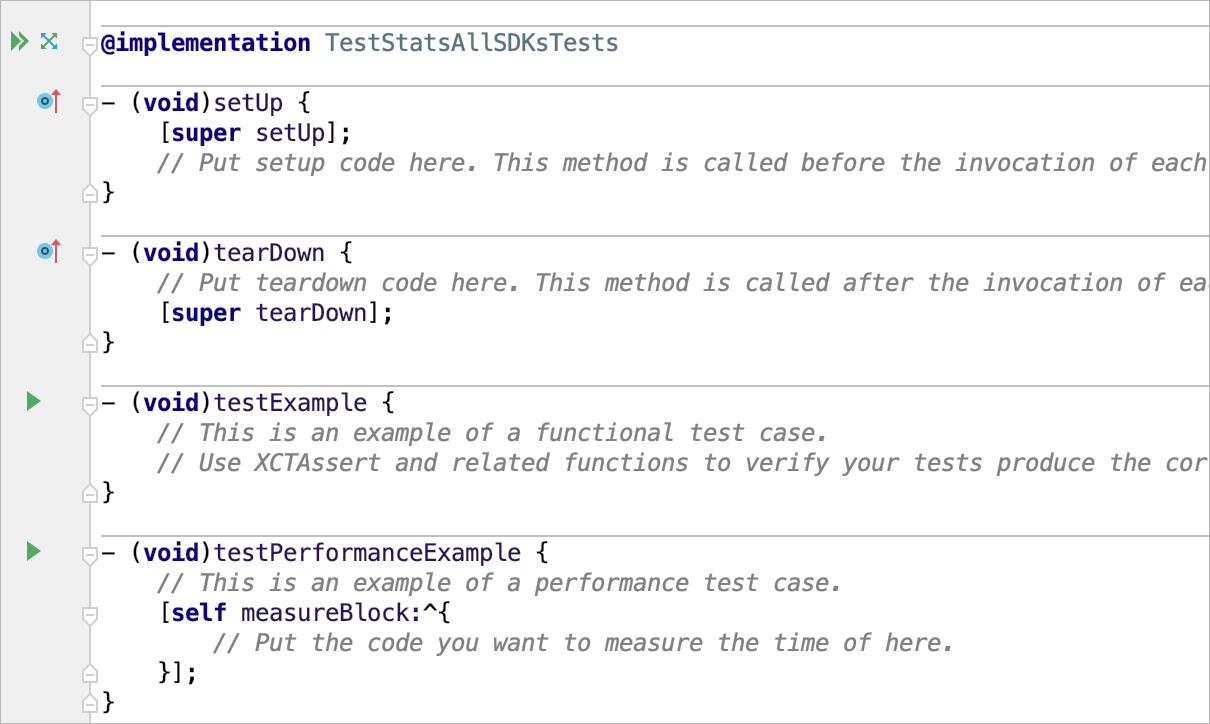
To open the Structure tool window, press ⌥7.
Use the Lens mode
The lens mode lets you preview your code without actually scrolling to it. The mode is available in the editor by default when you hover your mouse over the scrollbar. It is especially useful when you hover over a warning or an error message.
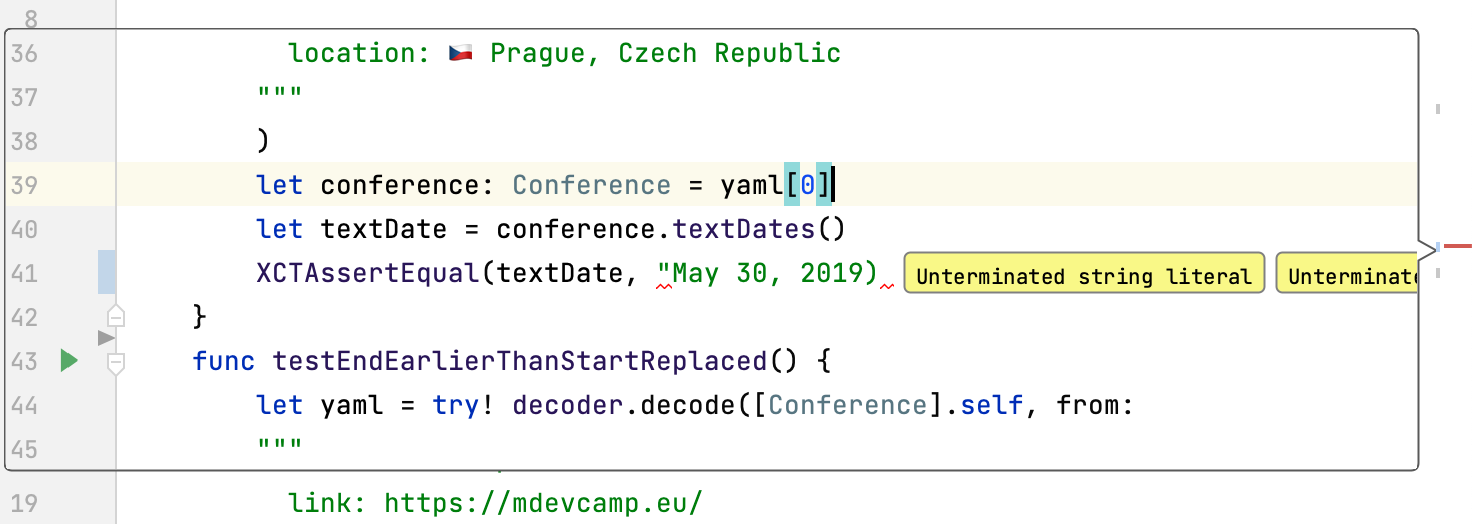
To disable the lens mode, right-click the code analysis marker located on the right side of the editor and in the context menu clear the Show code lens on the scrollbar hover checkbox.
As an alternative, in the Preferences dialog ⌃⌥S, go to and clear the Show code lens on the scrollbar hover checkbox.
Use breadcrumbs for navigation
You can navigate through the source code with breadcrumbs that show names of classes, variables, functions, methods, and tags in the currently opened file. By default, breadcrumbs are enabled and displayed at the bottom of the editor.

To change the location of breadcrumbs, right-click a breadcrumb, in the context menu select Breadcrumbs and the location preference.
To edit the breadcrumbs settings, in the Preferences dialog ⌃⌥S, go to .
Navigate to a file with the Navigation bar
Use the Navigation bar as a handy tool to find your way across the project.
Press ⌥↖ to activate the Navigation bar.
Use the arrow keys or the mouse pointer to locate the desired file.
Double-click the selected file, or press ⏎ to open it in the editor.
Find a line or a column
In the Go to Line/Column dialog, specify a line or column number, or both, separating them with : and click OK.

If you don't want to see the line numbers in the editor, in the Preferences dialog ⌃⌥S, go to and clear the Show line numbers checkbox.
Find a file path
In the editor, press ⌃⌥F12 or in the context menu, select .
In the Reveal in Finder popup, select a file or a directory to open in a path finder and press ⏎.
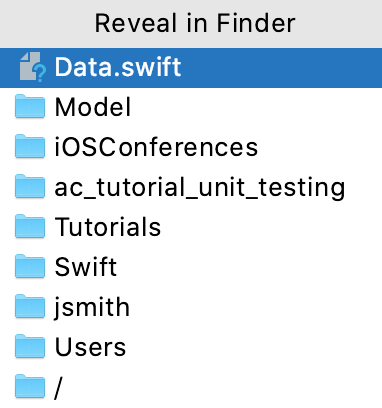
Find recent files
You can search for the recent and recently edited files with the Recent Files popup.
To open the Recent Files popup with the list of recent files, press ⌃E.
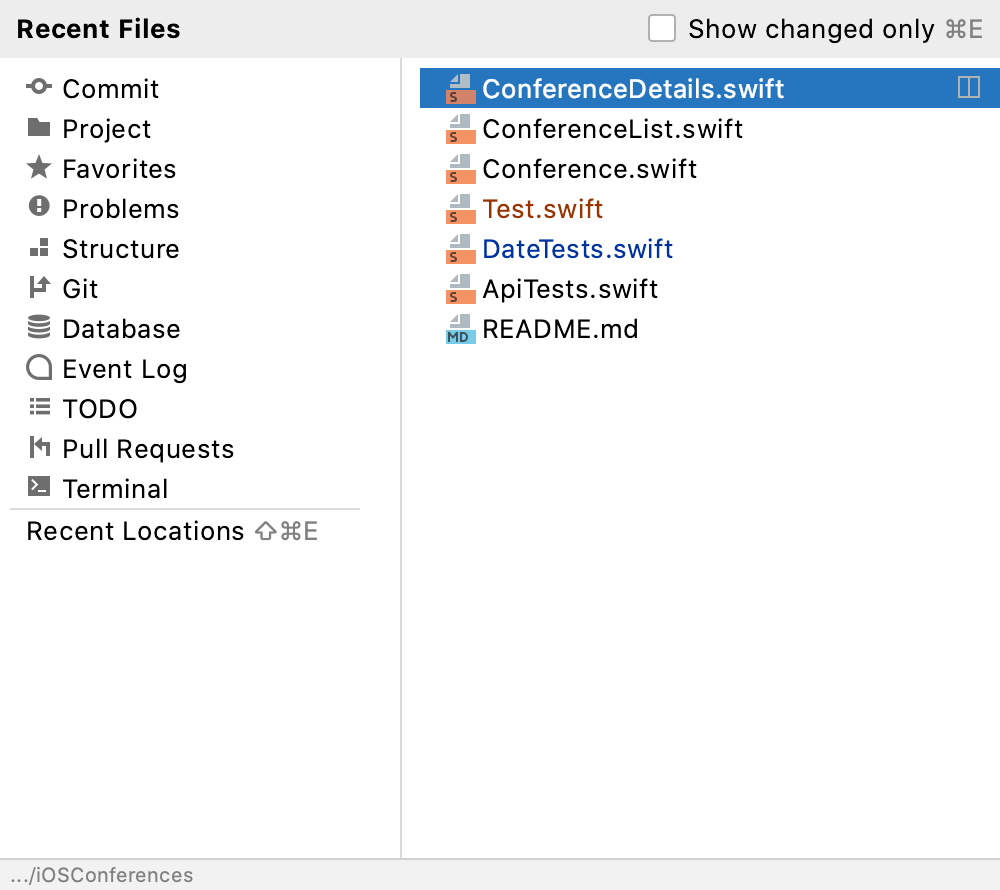
To see only the recently edited files, press ⌃E again or select the Show changed only checkbox.
To search for items in the popup, use the Speed Search functionality. Just start typing a search query, and the Search for field appears. AppCode displays the results based on your search query, the list shrinks as you type.
